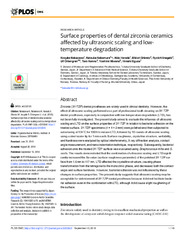Surface properties of dental zirconia ceramics affected by ultrasonic scaling and low-temperature degradation
Permanent lenke
https://hdl.handle.net/10037/14926Dato
2018-09-13Type
Journal articleTidsskriftartikkel
Peer reviewed
Forfatter
Nakazawa, Kosuke; Nakamura, Keisuke; Harada, Akio; Shirato, Midori; Inagaki, Ryoichi; Örtengren, Ulf; Kanno, Taro; Niwano, Yoshimi; Egusa, HiroshiSammendrag
Zirconia (3Y-TZP) dental prostheses are widely used in clinical dentistry. However, the
effect of ultrasonic scaling performed as a part of professional tooth cleaning on 3Y-TZP
dental prostheses, especially in conjunction with low-temperature degradation (LTD), has
not been fully investigated. The present study aimed to evaluate the influence of ultrasonic
scaling and LTD on the surface properties of 3Y-TZP in relation to bacterial adhesion on the
treated surface. 3Y-TZP specimens (4 × 4 × 2 mm) were polished and then subjected to
autoclaving at 134˚C for 100 h to induce LTD, followed by 10 rounds of ultrasonic scaling
using a steel scaler tip for 1 min each. Surface roughness, crystalline structure, wettability,
and hardness were analyzed by optical interferometry, X-ray diffraction analysis, contact
angle measurement, and nano-indentation technique, respectively. Subsequently, bacterial
adhesion onto the treated 3Y-TZP surface was evaluated using Streptococcus mitis and S.
oralis. The results demonstrated that the combination of ultrasonic scaling and LTD significantly increased the Sa value (surface roughness parameter) of the polished 3Y-TZP surface from 1.6 nm to 117 nm. LTD affected the crystalline structure, causing phase
transformation from the tetragonal to the monoclinic phase, and decreased both the contact
angle and surface hardness. However, bacterial adhesion was not influenced by these
changes in surface properties. The present study suggests that ultrasonic scaling may be
acceptable for debridement of 3Y-TZP dental prostheses because it did not facilitate bacterial adhesion even in the combination with LTD, although it did cause slight roughening of
the surface.


 English
English norsk
norsk